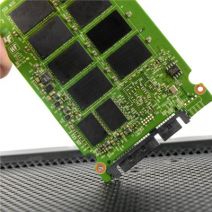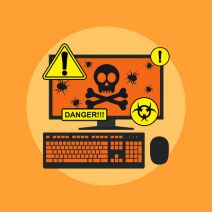Computerware Blog
Computerware has been serving the Vienna area since 1976, providing IT Support such as technical helpdesk support, computer support, and consulting to small and medium-sized businesses.
0 Comments
Mobile devices are important components of any modern workplace environment, and this trend is only growing more popular with time. Workers love the opportunity to use their own devices, like laptops or smartphones, and doing so is a trend known as Bring Your Own Device (BYOD). While this is a huge benefit for businesses that have trouble procuring equipment, it also presents several risks, many of which are associated with the Internet of Things (IoT).
Firewalls are easily one of the most basic parts of any network security infrastructure, and they’re an important component that shouldn’t be taken lightly. The firewall is the first line of defense against any threats coming into your network, and it’s one of several essential components to prevent data breaches on your network. An enterprise-level firewall is an important investment for any serious business.
The cloud grows more important for modern technology infrastructures by the day, and due to this, implementing the cloud isn’t simply a matter of when, but how. Some organizations still haven’t made the move to the cloud, but this is probably because they don’t understand the vast benefits that cloud computing can bring to the table.
With so much technology available to the modern worker, it’s easier than ever to work remotely. If your company takes advantage of remote technology, it has the potential to dramatically change things around the office for the better, thanks to its many benefits. Here are just a few benefits that every productivity-minded business will want to consider.
The latest technology solutions can provide incredible assets to your company, but they can be difficult to leverage properly if you’re not a professional technician. As the owner of a small or medium-sized business, you have an important decision to make: outsource your IT to talented professionals, or hire in-house IT technicians. More often than not, it’s more budget-friendly to outsource your IT.
Today’s business owners are more mobile than ever before. The modern worker is no longer tethered to their desk at the office, and instead, can work in ways which allow them to get the most out of their workday. Wireless technology is great, but how does it affect your network? Should you stick with a wired network connection, or should you try to make that wireless, too?
Today’s online business world prioritizes security more than anything else. While some businesses go above and beyond to keep compliant with their industry’s security best practices, others have trouble keeping up, and their network security suffers. Thus, monitoring account security on shared networks is of critical importance for any organization hoping to stay safe.
Can you tell the difference between a hard disk drive (HDD) and a solid-state drive (SSD)? The average consumer probably wouldn’t be able to understand the intricacies of either, but the fact remains that the two different types of drives have various advantages and disadvantages over the other. Understanding them is an important part of being a technology owner, and you should know what to expect from both hard disk drives and solid state drives.
Your business’s data backup solution is an absolutely integral part of your day-to-day operations, and as such, it’s your responsibility to ensure that you’re regularly taking backups of your data. By far, the most efficient way of doing so is through the utilization of image-based backup. Image-based backup works like how we use cameras and smartphones to capture moments in time, effectively making a record of your data at any given moment.
Technology management is a major pain point for small and medium-sized businesses. Some organizations might have an in-house team dedicated to handling all of the technology maintenance and management while others will choose to outsource this responsibility to a managed IT service provider. While going with an MSP for your business’s IT needs has its advantages, it also presents a unique set of challenges that must be overcome.
You know the old adage, “A chain is only as strong as its weakest link.” This means that a chain can be as powerful as it wants, but if too much stress is placed on a weak point, it will snap and become useless. The same goes for your network switches. Businesses are growing more reliant on wireless technology, and as such, you’re going to want to upgrade your network switches, or risk your “chain breaking,” so to speak.
For your organization’s technology infrastructure, you often have to make choices that are difficult. How do you resolve immediate problems, and how will your choice affect your IT down the line? Choosing between short-term IT (like break fix repairs) and long-term IT (like managed IT) isn’t a new one, but the differences between the two can often be lost to each other. In fact, we might argue that the two are meant for entirely different things!
Technology is always shifting to meet the demands and needs of its consumers, and as such, this often leads business owners to reconsider their solutions after setting up what appears to be the perfect network infrastructure. When new technology is introduced, it can dramatically affect your current solutions, so it’s a best practice to closely analyze new trends that appear with the latest technology.
Managing your vendors can be big trouble for a small business. While your organization’s productivity depends on their products and services, dealing with vendors is often an exhausting task that eats up a significant amount of time. By outsourcing this responsibility to a vendor management service, you can handle vendors much more efficiently.
A business generally focuses on protecting their network infrastructure from external threats that are found in the online environment. However, it’s important to ensure that your organization's network is protected from not just external threats, but any insider threats that could more easily compromise the security of your data.
Putting together an IT budget that’s a recipe for success is much more difficult than it sounds. Every year you run the risk of encountering crippling technology issues if you don’t take the proper precautions. If your budget isn’t prepared for problems with your IT infrastructure, it could have disastrous results. Here are five ways you can avoid skipping a beat when planning for your business’s IT budget.
When was the last time you put some serious thought into your data backup and disaster recovery strategy? Can your business handle a sudden loss of data, and if so, how long would it take your organization to recover and get back in the swing of things? While there are several ways you can approach the concept of data backup, only one of them will be the best choice for your business. So, how do you go about making such an important decision?
Behind the safety of a firewall and antivirus solution, it’s easy to forget that the Internet, and the online community in general, can be a dangerous place. It’s not until you fall prey to a hacking attack, virus infection, or similar threat that you become aware of the dangers that lie in the virtual darkness. However, these threats are only part of a more dangerous problem; social engineering hacks.
Everyone in your organization has a specific set of mission-critical software titles that they need to fulfill their day-to-day responsibilities, and the business owner is no exception. As an end-user yourself, how often do you worry about your software’s licenses? You wouldn’t believe how many organizations lose time and money due to expired licenses, or fall victim to hackers selling compromised copies of software to unsuspecting folks. What are the consequences of either of these circumstances?




















